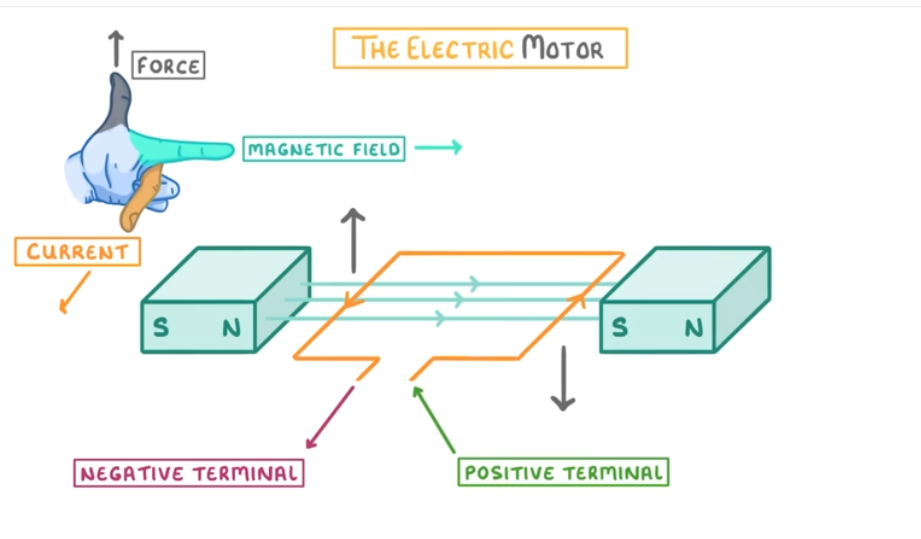The motor effect
1/19
There's no tags or description
Looks like no tags are added yet.
Name | Mastery | Learn | Test | Matching | Spaced |
|---|
No study sessions yet.
20 Terms
What is the motor effect?
The motor effect occurs when a current-carrying wire experiences a force due to the interaction between its magnetic field and an external magnetic field.
Why does the motor effect happen?
A current-carrying wire generates its own magnetic field, which interacts with an external magnetic field, causing a force on the wire.
When does the motor effect happen?
The wire must be in a magnetic field and perpendicular (or at an angle) to the field lines. No force acts if the wire is parallel to the field.
How can you predict the direction of the force in the motor effect?
Use Fleming’s Left-Hand Rule:
Thumb = Force (Motion)
First Finger = Magnetic Field (North to South)
Second Finger = Current (Positive to Negative)
How does changing the direction of the current or magnetic field affect the force?
Reversing the current reverses the force’s direction.
Reversing the magnetic field also reverses the force’s direction.
What affects the size of the force in the motor effect?
The force increases when:
Current increases
Magnetic field strength increases
The wire is at a 90° angle to the field
What is the equation to calculate the force on a current-carrying conductor?
F=BIL
Where:
F = Force (N)
B = Magnetic Flux Density (T, Tesla)
I = Current (A)
L = Length of wire in the field (m)
(Only applies when wire is perpendicular to the field!)
How can the direction of rotation of a motor be reversed?
Reverse the current
Reverse the magnetic field - by switching the poles
What is an electric motor?
An electric motor is a device that converts electrical energy into kinetic energy using the motor effect to produce rotation.
What causes an electric motor to rotate/how does it work?
When a current flows through a coil in a magnetic field, the motor effect produces opposite forces ( one acting down, the other acting upwards) on each side of the coil, making it rotate.

What is the function of the magnetic field in an electric motor?
The magnetic field interacts with the current in the coil, creating forces that cause the coil to spin.
How can you determine the direction of the force on the coil?
Use Fleming’s Left-Hand Rule:
Thumb = Direction of force (motion)
First Finger = Magnetic field (North to South)
Second Finger = Current (Positive to Negative)
(Each side of the coil experiences a force in opposite directions, making it rotate.)
Why do electric motors need a split-ring commutator?
The split-ring commutator:
Reverses the direction of the current every half-turn
Ensures the force always acts in the same direction
Keeps the motor spinning continuously
What can increase the speed of an electric motor?
Increase the current
Increase the strength of the magnetic field
Increase the number of turns in the coil
Use a stronger electromagnet
How can you change the direction of rotation of an electric motor?
Reverse the current direction
Reverse the magnetic field direction
What is the energy transfer in an electric motor?
Electrical energy (from the power source) → Kinetic energy (motor rotation)
Some energy is wasted as heat due to resistance in the wires.
What does the cone do in a loudspeaker?
The cone amplifies the vibrations of the coil, pushing air particles to create sound waves.
What is a loudspeaker?
A loudspeaker is a device that converts electrical energy into sound energy using the motor effect to create vibrations in a cone.
Describe how a loudspeaker produces sound.
1. An alternating current (AC) passes through a coil of wire.
2. The coil is placed inside a permanent magnet’s magnetic field.
3. The motor effect causes a force that moves the coil back and forth.
4. The coil is attached to a cone, which also moves.
5. The cone’s vibrations cause air particles to vibrate, producing sound waves.
Why must the current be alternating for a loudspeaker to work?
The alternating current (AC) continuously reverses direction, which makes the coil move back and forth, producing vibrations.